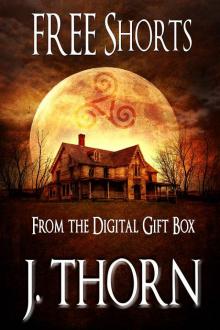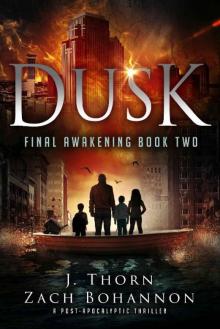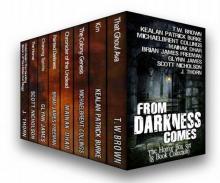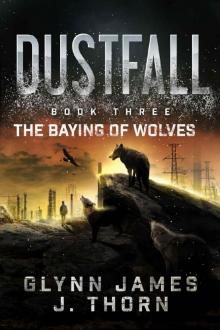This is the End 2: The Post-Apocalyptic Box Set (9 Book Collection) Read online
Page 3
But, strange as it sounded, I believed when I was tuning the TEV into spacetime, I could sense if I was hitting the fabric or not, then adjust accordingly.
Nothing supernatural about it. Just a genetic ability, like being good at basketball, or having 20/20 eyesight. Still, I didn’t talk about it much, for fear of being laughed out of the Peace Department.
So I took a deep breath, let it out slow, then reached for the dial to see where this blood came from.
FOUR
When I’m tuning in to the spacetime fabric, my brain sort of splits in half. Not literally, or even figuratively. But I don’t really know how else to describe it. One part of my mind is intensely focused. The other part just spaces out, like I’m daydreaming.
Each click of the focus dial is one-hundredth of a millimeter, and most people can’t distinguish the movement. But to me, each click feels like a huge chasm that I’m traversing in slow motion. People watching me have commented that my fingers aren’t moving at all. But they are, on a very sensitive, very minuscule level.
First I needed to locate the eighth membrane. According to Michio Sata, the world’s first timecaster and the genius who helped invent the technology, there was no way to actually locate its physical presence. Either you could sense it, or you couldn’t. I could, and when I tuned in to the 8M I sensed that it looked and felt like a furry, bloated, red raisin. But the descriptors looked and felt aren’t appropriate, because I really couldn’t see or feel anything. It was all happening in my head.
Even though I hadn’t done a visualization in a long time, I focused in on the 8M pretty quickly. But it seemed strange. A little too small. A little too orange. I chalked that up to being out of practice, and then switched from the focus dial to the fine-tuning dial.
If one out of a thousand could locate the membrane, only a fraction of them could fine-tune. Unlike the raisin sensation, fine-tuning appeared in my imagination like a long, winding road. I had to follow its twists and turns, using the dial, maneuvering this way and that way until I reached the pinpoint of light at the very end. But it wasn’t actually light. It was more like a single point that pulled light in.
The point itself was weird as hell, and supposedly different for everyone who found it. But if you could sense the point, getting to it wasn’t any more difficult than driving a vehicle.
“Oh, my…”
I opened my eyes and looked at Neil, who appeared to be disappearing and reappearing, switching on and off like a flickering monitor. Actually, it was me and the TEV who were disappearing. Though I didn’t understand the science or the math, I was getting close to the octeract point; the center of the spacetime eighth-dimensional hypercube. While I didn’t understand what any of that meant, I knew what it felt like when I got there.
Strangely, it felt like petting a bunny between the ears.
As I got closer, the octeract point unfolded, and I sensed my mind being stretched, like it was made of chewing gum and someone was tugging on either end. One more delicate twist of the fine-tuning dial and the light enveloped everything, providing me with the very real but decidedly un-macho bunny sensation.
I locked the dials. The flickering had stopped. The world was tangible and real again. Neil’s jaw was hanging open.
“Close your mouth, Neil, or you’ll accidentally swallow the eighth dimension and your head will explode.”
His jaw clicked shut at my lie. Newbies were so much fun to mess with.
I directed my attention to the TEV monitor. It looked like a live video. The lens was pointed at the sink, and the monitor showed the sink. But when I waved my hand in front of the lens, it didn’t appear on the monitor.
That was because we weren’t looking at the sink in present time. We were looking at the sink from seventy-two hours ago. The liquid display was round and full-color, highly realistic, on par with the best real-definition displays. It had filters to compensate for the way light reflected off objects. Unfiltered, the center image was tinted blue, and around the edges was a deep red—blueshift and redshift due to the Doppler effect.
I checked the filters and tweaked them, because the current image was a bit too orange. Unable to lock it in, I played with the hue, trying to match the colors in the room. Eventually I got it looking pretty close.
“Incredible,” Neil said.
“Shh. Mouth closed.”
He obeyed, pursing his lips. I hit the fast-forward button, resuming play again when I saw a woman go to this sink. She was older, gray hair, comfortable shoes, wearing a combination of purple and green that only the elderly could get away with. I watched her place an empty plate in the sink, then drain the last drops of what looked like liquor from a rocks glass. Enjoying her alcohol still, apparently.
I looked away from the monitor, into the sink. The plate and glass were still there.
“Oh…”
At Neil’s gasp I glanced back at the monitor.
It was ugly.
A man in a black jumpsuit and gloves had come up behind Aunt Zelda and was ramming her face into the sink. After the third crack, he placed his hands on her ears and with one violent turn—he twisted her head 180 degrees, so it was facing the opposite way.
Neil made a gagging sound. I hit the pause button. From this angle, all I could see was the back of the man’s head. He had dark hair, a muscular build, and his jumpsuit looked like a uniform of some sort. I picked up the TEV by the handle, and walked it to the other side of the sink. While the action on the monitor remained paused, the angle changed as the lens moved, allowing me to view the scene from a different perspective. I set down the TEV and zoomed in, getting a close-up of the bastard’s face.
“Totally fuct!” Neil uttered.
Totally fuct was right.
The murderer looked exactly like me.
His hair was darker than mine, and slightly longer than I wore it. But everything else about him was identical.
“You! You killed her!” Neil backpedaled, raising up his hands in case I was going to grab him and twist his head off.
“I didn’t kill her, Neil.” I was shocked, but kept my voice even. “That’s just someone who looks like me. A disguise. Or someone with facial reconstruction. Might even be a clone.”
Neil’s voice was shaky. “He’s your age. He would have had to have been cloned at the same time as your birth.”
“Look, I’ll prove it isn’t me.”
I zoomed out and switched the resolution from the visible spectrum to a preprogrammed wavelength and frequency, bringing up an electromagnetic radiation resolution. The effect was similar to old-fashioned X-rays. The killer and Aunt Zelda became phosphorescent skeletons. I used the joystick to focus in on the man’s wrist, then zoomed in.
His chip filled the screen. A twenty-digit ID number, followed by the birth name.
I paused it, and then got an even bigger shock.
The ID number, and the name, were mine.
“You killed her,” Neil whispered.
“The…uh…chip has to be a counterfeit.”
“It’s impossible to counterfeit chips. They’re specific to individual DNA.”
I zoomed in even more, to a microscopic level, seeing the nanocircuits trading electrical impulses with nerve endings. The chip had indeed fused with this guy’s biological system. It was real.
That was all the confirmation Neil needed, because he turned tail and ran for the door, yelling, “Fuct! Fuct, fuct!” and waving his hands in the air.
So I did the only thing I could do.
I drew my Glock and shot him in the back.
FIVE
My Glock 1MV fired wax bullets, each housing a barbed needle attached to a microprocessor that was directly linked to my account. The slug hit Neil between the shoulder blades and the wax broke away, leaving the needle embedded fifteen millimeters into his shirt and skin. At the speed of light, the processor accessed my Tesla billing ID number, and a tiny lightning bolt shot out from the ceiling and gave Neil a taste of on
e million volts. The same wireless electricity system that powered the city also powered my bullets.
For a nonlethal weapon, the Glock Taser was still pretty nasty, and I knew from experience it hurt like hell. Neil plopped onto his face, unable to break his fall with his hands because his entire skeletomuscular system locked up. He flopped around on the floor for a bit, and I hit the remote control on my utility belt, shutting off the juice. Then I removed a supplication collar from its case and locked the thin strip of adonized plastic around his neck.
“Fuct…” Neil moaned into the carpeting.
I holstered my roscoe and took the EPF activator—a silver sphere no bigger than a hypergolf ball—and placed it next to the front door, setting the distance at two meters.
With Neil taken care of, I went back to the kitchen and stared at the TEV monitor, my face staring back at me. Tachyon emission visualization technology was foolproof. It couldn’t be compromised. It couldn’t be faked. The TEV was better than any eyewitness, because it showed the truth without perception or bias getting in the way.
But this wasn’t the truth. At the time of the murder, I was home with Vicki. I had an alibi.
Of course, the famous court case of the State of Illinois v. Joseph Andrew Konrath showed that alibis meant nothing against TEV evidence.
I picked up the unit and hit rewind, keeping the lens on the killer. I watched the murder in reverse, and then saw him sneak away from Aunt Zelda, walking backward. I followed him, through the hallway, to the apartment door.
Outside the door, I watched him use a smart magnet on the lock. Smart magnets were used by locksmiths, when electronic entry failed due to mechanical error. Prior to the invention of timecasting technology, burglars used them to gain entrance to homes. But B and E was a thing of the past, because all a timecaster had to do was follow the thief all the way home, either forward or in reverse. Which was what I planned on doing with my double.
He led me to the elevator. But right before he stepped out, the monitor flickered.
And he disappeared.
I pressed fast-forward and watched it again.
One millisecond he was there. The next he wasn’t.
I tuned in to the exact frame of his vanishing act, trying to spot where Alter-Talon went. Alter-Talon didn’t go anywhere. He completely dematerialized. Which was, of course, impossible. The only difference between the before and after frames was the hallway lighting. Before he disappeared, it was slightly bluer. When he appeared, the light became a bit oranger.
“Fuct!” Neil screamed, high-pitched and decidedly un-macho.
I glanced over at Aunt Zelda’s open door, then walked back inside her apartment.
Neil was on his ass, eyes bugging out, both hands gripping the supplication collar. His whole body shook. I grabbed his shirt and dragged him away from the door, back into the hallway.
“I put an electronic perimeter fence by the door. If you get within two meters, it shocks you. But you apparently figured that out.”
Neil was gasping like he’d been underwater. “You…killed her.”
“I didn’t kill her.”
His eyes welled up. “Please let me go.”
“Sorry. I can’t do that just yet. If you go running to the Peace Department, they’ll put me away before I have a chance to figure out what’s going on. So you’ll have to stay put for a while.”
Neil pouted, and a trembling hand reached up for his earlobe.
“It also jams your headphone. And if you try to cut it off, it explodes, blowing a hole in your neck.”
The last part was a lie, but I wasn’t too concerned with Neil getting the collar off. It was reinforced with carbon nanotube fibers. They were the strongest things on the planet, and were used to tether space elevators to earth. Unless Aunt Zelda had a diamond bit drill, the supplication collar would stay on until I took it off.
Then I went back to the TEV. Instead of reverse, I let the past move forward. The murder was just as horrible the second time. Even more so, because I zoomed in on the killer’s face as he snapped her neck, and the SMF was smiling.
It got worse. After her death, the alter-me pulled something out of a sheath on his belt. From my viewing angle, it appeared to be nothing more than an empty handle. But I knew what it was.
A Nife.
The Nife, or nanoknife, was yet another miracle courtesy of carbon nanotubes. It had a tensile strength sixty times greater than diamonds. From the side, it looked like a military KA-BAR knife. But the Nife was invisible while looking at it edge-on because it was incredibly thin—1/10,000th the width of a human hair. This also made it incredibly sharp, and equally dangerous. Only the mentally compromised carried Nifes. It was too easy to cut off your own leg sheathing it, and you wouldn’t even know until you tried to take a step and your leg stayed behind.
The killer used his Nife to fillet the skin away from the vic’s arm, layer by layer, down to her chip. Then, with an expert flick, he dug the chip out and walked off.
Neil made a gagging sound.
I kept the lens on the killer, watched him approach the microwave. He set the timer on twenty minutes.
I paused the TEV and went to the microwave, wincing at the smell when I opened the door. All that was left of the chip was black ash. Hence Neil’s inability to locate his aunt using GPS. I went back to the visualization, letting it play out.
After the cut and bake, he focused on the refrigerator, unloading all of the food and placing it in the biorecycle chute. Then he removed the shelves and stacked them in the cabinet under the sink. It didn’t take a timecaster to see what was going to happen next. I paused the transmission and stared at the fridge for a few seconds, my stomach becoming unhappy. Then I tugged open the door.
Aunt Zelda’s frozen, lifeless eyes stared back at me. Her jaw was stretched open, impossibly wide, in a horrifying silent scream.
“You put her in the icebox?” Neil blubbered. “You’re inhuman.”
I ignored him, following protocol and checking for a pulse that I knew wasn’t there. Her skin was cold to the touch. I patted her down, checking her pockets, and came up empty. Then I let the TEV play out the rest of the crime. After stuffing the vic into the chill chest, Alter-Talon walked out the front door. I followed him into the hallway, over to the elevator—where he disappeared into thin air right before he climbed on.
SIX
The Mastermind checks the time. He wonders how long this
is going to take. Wonders if it will play out according to plan. The tension is delicious. It all began as an experiment. One he wasn’t even sure he’d
go through with. But it fed on itself. Got bigger. More seductive. Planning and scheming had to become action. Knowledge is for using, not hoarding.
The testing period had been heady. Exhilarating. But the true potential of what he’d accomplished hadn’t been realized until now.
What started as a solo was quickly becoming an ensemble piece. So many layers. So many variables. Such fun. He waits, forcing patience, while he really wants to run around and cheer. Shout. Scream. There’s much left to do. But too many variables. So he listens. And he waits. The mouse has found the cheese. Soon the trap will spring.
SEVEN
WTF?
I played the rewind/pause/fast-forward game again, but the results were the same as before. One moment Alter-Talon existed. The next moment he didn’t. If I wasn’t 100 percent positive I was watching an actual past event, I’d think someone somehow tampered with the transmission.
But TEV was tamperproof. The past was the past, and couldn’t be changed or faked. The only reason I didn’t think I killed Aunt Zelda was because I didn’t kill Aunt Zelda. Even though every bit of evidence pointed to the contrary.
I turned to Neil, who was sitting at the breakfast bar on a stool, one eye on me and the other on the EPF at the front door.
“Neil, did your aunt have any enemies?”
His nose was running, and he sniffled. “Are you going
to kill me?”
I sighed. “I’m a peace officer, Neil. I don’t kill people.”
“I’m sure that’s a huge reassurance to the dead woman in the refrigerator.”
“Enemies, Neil. Did she have any?”
“You mean besides you?”
I thought about hitting a button on the remote control and activating either the Taser needle or the supplication collar. Or both. But as a representative of the law, I was limited in the use of force when questioning subjects. In fact, I wasn’t legally allowed to ask Neil anything without counsel present on both sides. But then, I wasn’t placing Neil under arrest. The only one who could be brought up on charges in this room was me.
“Your aunt has a lot of nice things,” I said, noticing a painting on the wall. It was real art, not a monitor. Old paintings, and the organic canvases they were painted on, were spared from the Great Recycling Effort with a grandfather clause. You didn’t see too many of them outside of museums. “Was she employed?”
“Retired.”
“From what?”
He sniffled again, a big one that sucked in a long line of snot that had been hanging down his chin. “Are you going to kill me?”
He looked like a whipped dog, and if he had a tail, it would surely be between his legs. But when I stared at him, I couldn’t help but see him on top of my wife, grunting away. That didn’t leave me much left in the sympathy department.
“Honestly, Neil, I’m starting to consider it. Can you tell me anything at all relevant to what might be happening here?”
His shoulders shook. “I shouldn’t have gone to you. This was a huge mistake. Are you going to put me in the icebox?”
Neil started to cry. I rubbed my jaw and decided to take a closer look around. Aunt Zelda had books and a painting, both indicators of wealth. I wondered what else she had around the old homestead.

_preview.jpg) The Hunt (A Chilling Vampire Short Story)
The Hunt (A Chilling Vampire Short Story) BARREN_A Post-Apocalyptic Thriller
BARREN_A Post-Apocalyptic Thriller Dustfall, Book Two - The Parting of Ways
Dustfall, Book Two - The Parting of Ways Dustfall, Book Five - What Lies Beneath
Dustfall, Book Five - What Lies Beneath Dustfall, Book Three - The Baying of Wolves
Dustfall, Book Three - The Baying of Wolves Preta's Realm
Preta's Realm BARREN: Blood Moon
BARREN: Blood Moon The FREE Digital Gift Box - Short Stories
The FREE Digital Gift Box - Short Stories American Demon Hunters_An Urban Fantasy Supernatural Thriller
American Demon Hunters_An Urban Fantasy Supernatural Thriller The Hunt
The Hunt The Complete Hidden Evil Trilogy: 3 Novels and 4 Shorts of Frightening Horror (PLUS Book I of the Portal Arcane Trilogy)
The Complete Hidden Evil Trilogy: 3 Novels and 4 Shorts of Frightening Horror (PLUS Book I of the Portal Arcane Trilogy) Uprising
Uprising The Seventh Seal
The Seventh Seal This is the End 3: The Post-Apocalyptic Box Set (8 Book Collection)
This is the End 3: The Post-Apocalyptic Box Set (8 Book Collection) The Parting of Ways
The Parting of Ways BARREN_Book 2 - Escape from the Ruins
BARREN_Book 2 - Escape from the Ruins From Darkness Comes: The Horror Box Set (8 Book Collection)
From Darkness Comes: The Horror Box Set (8 Book Collection) Box of Runes An Epic Fantasy Collection
Box of Runes An Epic Fantasy Collection Night: Final Awakening Book Three (A Post-Apocalyptic Thriller)
Night: Final Awakening Book Three (A Post-Apocalyptic Thriller) Invasion
Invasion Evil Origins: A Horror & Dark Fantasy Collection
Evil Origins: A Horror & Dark Fantasy Collection Dustfall, Book One - Shadows of a Lost Age
Dustfall, Book One - Shadows of a Lost Age BARREN: Book 2 - Escape from the Ruins (A Post-Apocalyptic Thriller)
BARREN: Book 2 - Escape from the Ruins (A Post-Apocalyptic Thriller) Dusk: Final Awakening Book Two (A Post-Apocalyptic Thriller)
Dusk: Final Awakening Book Two (A Post-Apocalyptic Thriller) Corrosion: Terminal Horizon (The Portal Arcane Series - Book III)
Corrosion: Terminal Horizon (The Portal Arcane Series - Book III) Final Awakening (Book 1): Dawn
Final Awakening (Book 1): Dawn From Darkness Comes: The Horror Box Set
From Darkness Comes: The Horror Box Set Reversion: The Inevitable Horror (The Portal Arcane Series - Book I)
Reversion: The Inevitable Horror (The Portal Arcane Series - Book I) Voices From Beyond Volume 1
Voices From Beyond Volume 1 Dawn: Final Awakening Book One (A Post-Apocalyptic Thriller)
Dawn: Final Awakening Book One (A Post-Apocalyptic Thriller) J.R. Rain's Vampire for Hire World_Vampire Apocalypse
J.R. Rain's Vampire for Hire World_Vampire Apocalypse Vampire Apocalypse
Vampire Apocalypse Shadow Witch: Horror of the Dark Forest
Shadow Witch: Horror of the Dark Forest This is the End 2: The Post-Apocalyptic Box Set (9 Book Collection)
This is the End 2: The Post-Apocalyptic Box Set (9 Book Collection) The Baying of Wolves
The Baying of Wolves The Law of Three: A New Wasteland (The Portal Arcane Series - Book II)
The Law of Three: A New Wasteland (The Portal Arcane Series - Book II)